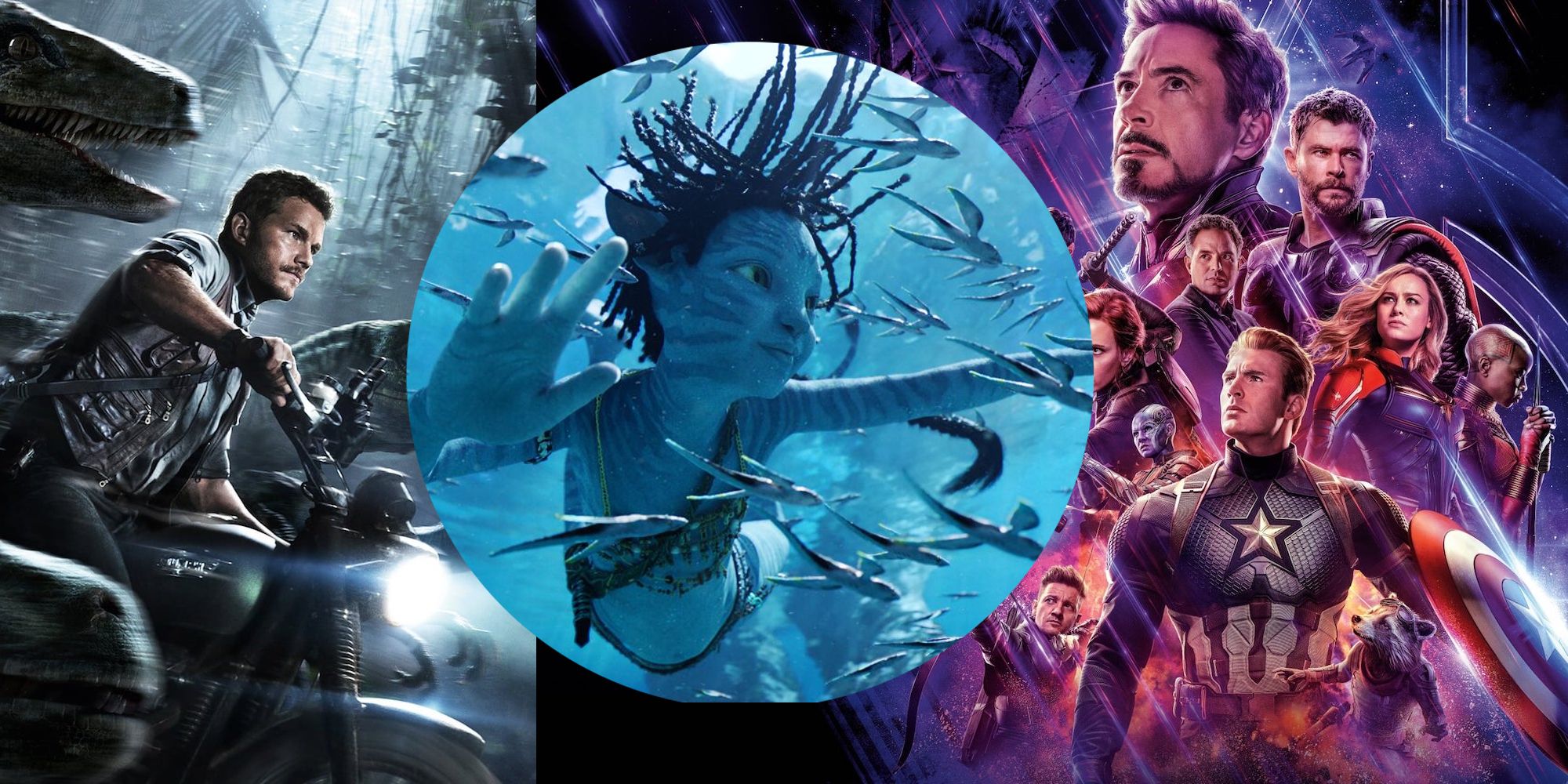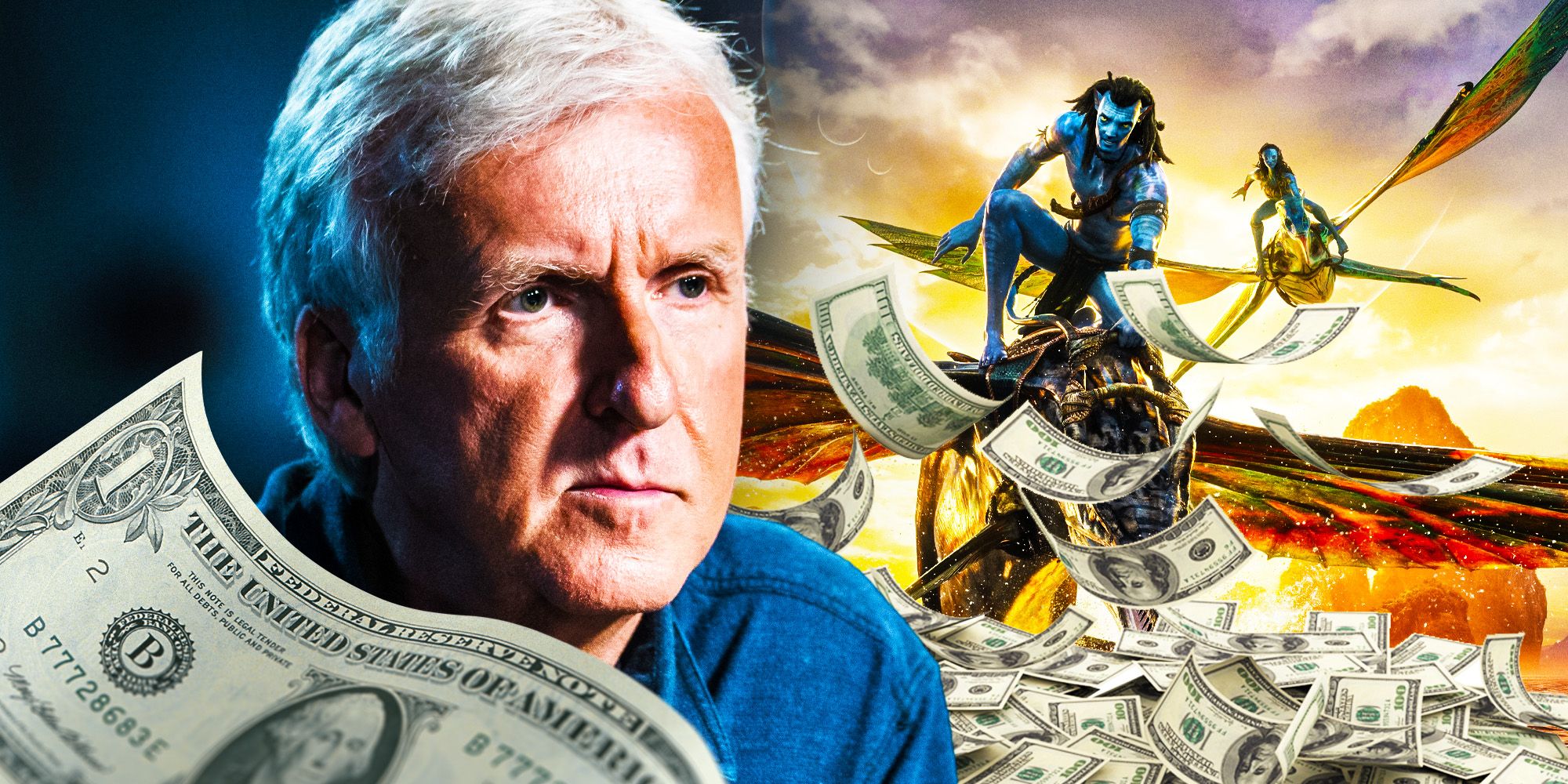[ad_1]
Avatar: The Way of Water‘s massive box office success is a good thing, but it also revealed some major failures of the broken modern box office. Despite some recent big hits as audiences return to theaters, comparing modern box office numbers to the performance of some historical blockbusters reveals a big change in the performance of Hollywood’s biggest movies, signaling a significant decline in box office health.
While Avatar: The Way of Water opened below projections, it went on to defy expectations, outperforming most of the movies in the top 10 box office, proving the impressive performances of some of the biggest box office hits in history are more broken than people realize. The box office performance of Avatar: The Way of Water and James Cameron’s other movies in the top 10 have far more in common with an older era of box office behemoths, and help remind everyone of what a truly healthy box office run looks like.
Theater Attendance Has Been in Decline For Decades (Despite Pre-Pandemic Box Office Gains)
Post-pandemic box office recovery is typically compared to 2019’s record-setting revenue, but theaters were in trouble long before that. Actual ticket sales were already in decline for decades, and observed revenue increases are only the product of inflation-driven price increases and therefore not actually a sign of growth. Eight of the top 10 domestic box office earners have been released since 2012, and half are newer than 2018. Adjusting for inflation immediately reveals this problem. For example, Titanic earned $600 million domestically during its initial 1997 theatrical run. Adjusted for inflation, that becomes $1.12 billion, higher than any other movie (without even counting the $57 million from its 2012 3D re-release).
Looking at movies that aren’t even on the current domestic top 10 list, Shrek 2‘s $441.2 million domestically in 2004, which equates to $707 million today, which would put it ahead of Black Panther as the #6 all-time domestic earner. Star Wars: The Phantom Menace earned $431 million in 1999, which is $778.7 million today, putting it ahead of Top Gun Maverick for the #4 all-time. Jurassic Park earned $357 million in 1993, which is $743.1 today, also enough for #5 domestically in today’s dollars. Going even farther back, E.T. the Extra-Terrestrial earned $359.2 million domestically in 1982, which is $1.13 billion today, putting it even ahead of Titanic‘s inflation-adjusted total.
So, even though new movies are joining the top 10 domestic earners list almost every year, pushing older movies down the list, it’s clear the actual economic value of these movies isn’t climbing drastically, it’s just that the measuring stick used to gauge their success (the dollar) is changing. While the success of big modern movies can’t be denied, applying the balancing lens of inflation to the box office reveals how massive movies like Avatar: The Way of Water and Top Gun: Maverick aren’t necessarily massive breakouts as their inflation-driven numbers would suggest, but merely examples of what a historically healthy box office should look like.
Box Office Openings Are Getting Bigger, But Legs Are Getting Worse
Modern box office trends and inflation don’t merely confuse the context of a movie’s total domestic box office haul, but also the way it’s earned. Avatar: The Way of Water was a huge box office success despite a lower opening weekend. While big modern blockbusters have created expectations of massive opening weekends being the best or only way to achieve a high level of box office success, big hits with lower opening weekends like Avatar, Titanic, Avatar: The Way of Water, and Top Gun Maverick reveal a healthier trend more in-line with historic box office behemoths like Jurassic Park and E.T. the Extra-Terrestrial.
Measuring a movie’s total domestic performance as a factor of its opening weekend is one of the best ways to measure while eliminating inflation-driven differences across the decades. The product of a movie’s opening weekend box office and its “multiplier” equals its total domestic run, so a bigger multiplier means better legs, indicating better word of mouth and repeat business, and is a good sign of overall box office health. Titanic‘s 23.02 multiplier is the best in the current top 10, while Avatar‘s 10.19 is the second highest; however, the other eight movies not directed by James Cameron average out to 2.91, and it has been trending downward for decades.
The average multiplier for every #1 movie in the 2010s was 3.13, the average #1 movie of the 2000s was 4.73, the average #1 movie of the 1990s was 9.67, and the average #1 movie of the 1980s was 20.85. Since this only accounts for the top movie of each year it may not be fully representative, but the downward box office trend is still clear. So, not only do modern blockbusters not necessarily even earn more at the box office, but the way they do it is far less healthy. It’s the economic equivalent of a diet primarily consisting of sugar, creating short-term spikes in energy, but perpetuating a long-term decline in health.
To more fully illustrate this sugar crash, the average second-weekend drop in box office revenue for the #1 movie of each year in the 2010s was 56.56 percent, the average for #1 movies in the 2000s was 20.21 percent, the average for #1 movies in the 1990s was 20.21 percent, and the average for #1 movies the 1980s was 7.54 percent. Additionally, while none of the #1 movies after the turn of the century saw a week 2 increase, it happened twice in the ’90s (Titanic and Ghost) and four times in the ’80s (Rain Man, Fatal Attraction, Top Gun, and E.T. the Extra-Terrestrial).
Avatar 2 And James Cameron Movies Perform More Like OLD Box Office Hits
Avatar: The Way of Water‘s box office success already stands in contrast to every other non-Cameron movie in the top 10. It doesn’t hold a candle to the historic performances of movies like E.T. the Extra-Terrestrial or Jurassic Park, but the ways it diverges from modern blockbusters are ways that make its performance more closely resemble the healthier box office behavior of those classic blockbusters. The average top 10 non-Cameron movie has a $234 million opening weekend, a 2.91 multiplier, and a $681 million domestic total. Meanwhile, Avatar: The Way of Water opened to $134 million, a 5.09 multiplier, and a $659.7 million domestic total.
While Avatar: The Way of Water trends towards more classic box office behavior compared to other modern hits, the behavior is even more apparent in Cameron’s other top 10 movies. The original Avatar opened to $77 million, has a 10.19 multiplier, and earned $785.2 million domestically while Titanic opened to $28.6 million, has a 23.02 multiplier, and earned $659.3 million domestically. All three of Cameron’s movies in the top 10 list also earned 70 percent of their total box office internationally, driving worldwide totals to $2.9 billion for Avatar, $2.2 billion for Titanic, and $1.8 billion (so far) for Avatar: The Way of Water.
Both Avatar and Titanic‘s massive box office hauls are secure in an inflation-adjusted top 10 list, and it’s notable that all three movies have the lowest opening weekends of any of the current unadjusted top 10 and the three highest multipliers out of the unadjusted top 10. This means their long-haul totals come from massive sustained word-of-mouth and repeat viewings. This may or may not indicate anything about the subjective quality or entertainment value of these movies, but it does mean their performance is far more stable and healthy than other top 10 movies.
Fortunately, James Cameron’s movies aren’t the only movies following these more healthy box office patterns. Top Gun: Maverick is another recent example of a movie with a relatively low opening weekend and strong long-term legs. In fact, Top Gun: Maverick out-grossed Avatar: The Way of Water domestically, meaning its failure to crack the top 10 list is due to its international performance, which only accounted for 48 percent of its box office (compared to the 70 percent for all three Cameron movies in the top 10), largely due to it not getting released in China.
In a post-pandemic box office struggling to return to the revenue peak of 2019, it’s possible the numbers will never fully recover; however, that doesn’t mean box office health can’t recover. If the box office turmoil results in more movies seeing broader hits with better long-tail success like Avatar: The Way of Water and Top Gun: Maverick and fewer movies with massive opening weekend spikes and steep drops, the broken theatrical model may begin to heal, securing a stable future for the theatrical model so audiences can continue to experience larger than life stories on the big screen.
Key Release Dates
[ad_2]
Source link


